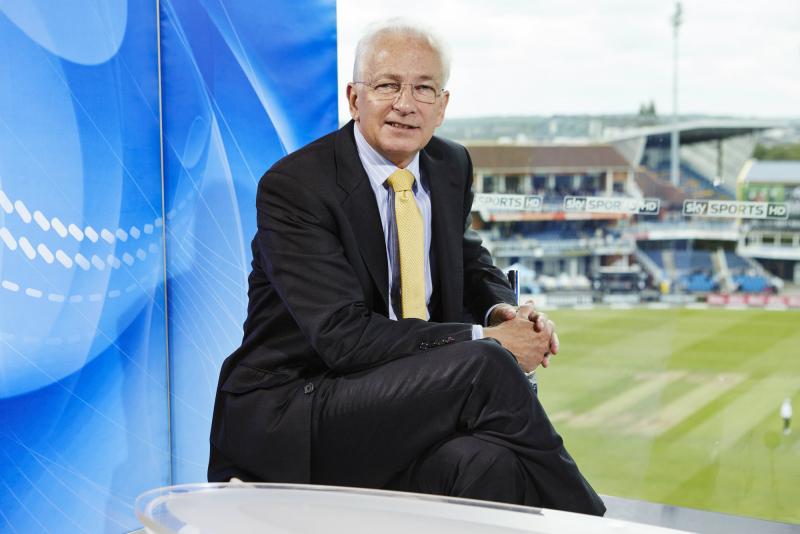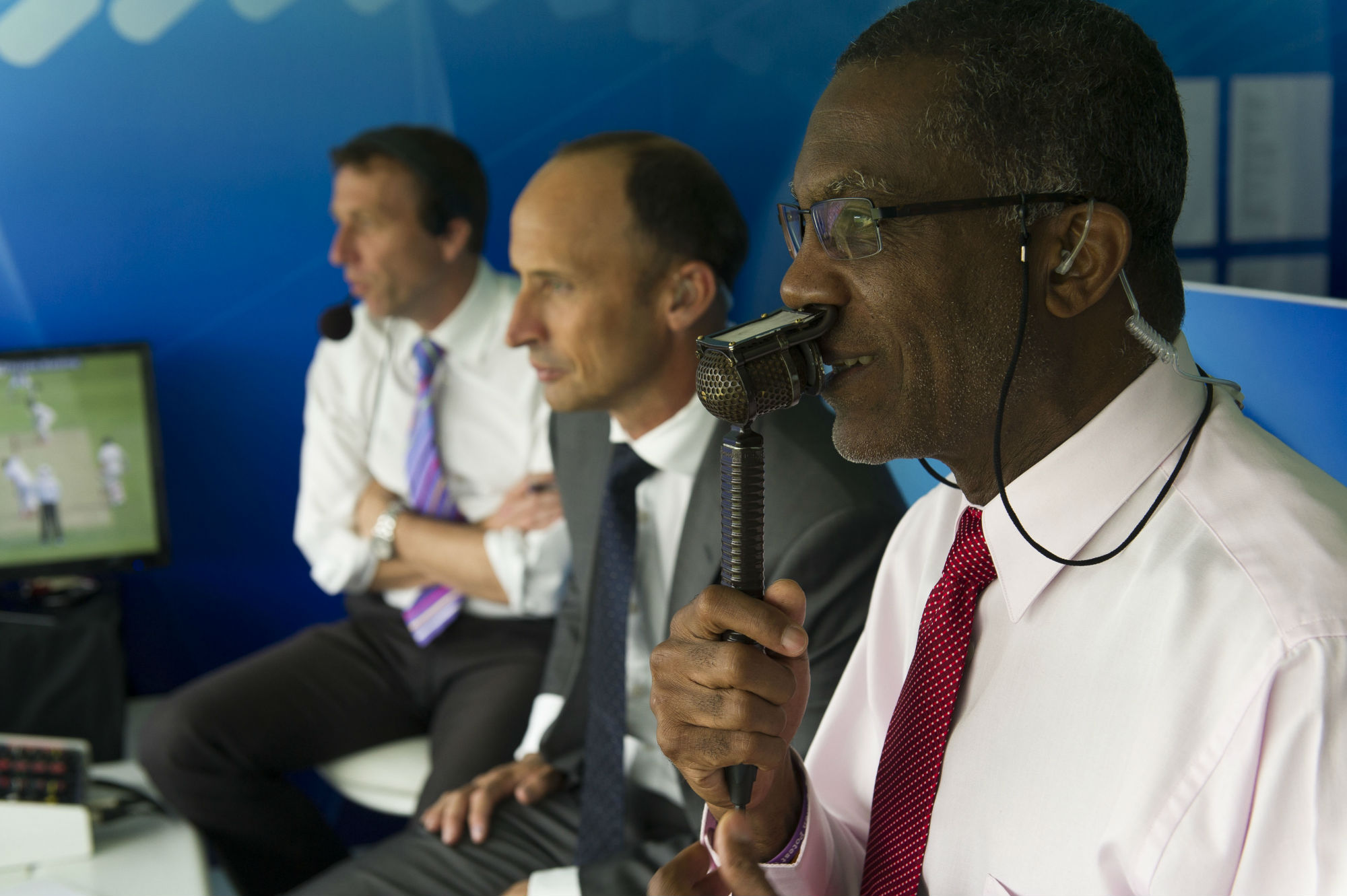The Ashes, Sky Sports Ashes / Channel 5 | reviews, news & interviews
The Ashes, Sky Sports Ashes / Channel 5
The Ashes, Sky Sports Ashes / Channel 5
All-male television commentaries, but the radio even has some women on the job

22 men with clubs and Neanderthal facial hair, fighting an ancient, ritualised turf war over a symbolic, cremated token… No sooner did you think the latest series of Game of Thrones had finished than a bunch of feisty blokes from somewhere far scarier and more violent than Westeros pitch up and start throwing heavy objects around.
Sky Sports paid an estimated £280m for the rights for live international cricket, 2013-17, and with that sort of money at stake, you don’t want the second XI presenting your show. Their studio is stuffed with captains and other veterans mentioned in dispatches from the past few decades’ competitions. Many of these presenters, especially David Gower, Sir Ian Botham and Australian bowling genius Shane Warne, used to have a reputation for varieties of hell-raising, but dress them in chinos and a club tie, and sit them together on a sofa, and the result is slightly soporific.
With Sky, you definitely enter the Bloke Zone. This equates, in sport as in politics, to unhealthy levels of mutually reinforcing egotism. The sound of alpha egos being pampered - think a cross between a purr and the clucking of a well-fed cockerel - doesn’t make especially lively, anecdote-filled telly. Sometimes a former captain’s expertise yields helpful insight (generally Michael Atherton is the most perceptive, with Michael Holding - pictured below with Atherton and Nasser Hussain - refreshingly crisp and headmasterly), but it doesn’t always generate a great atmosphere, or sense of struggle, listening to people who usually won. Some of the best communicators, such as cricket writer Ed Smith, or BBC commentator Henry Blofeld, were less convincing players, but would be much more engaging to be stuck in a lift with.
 Where money does undoubtedly help is in the preparation of relevant background information, and what really impresses with Sky’s coverage is the depth of supporting clips and animations. Points commentators make about a player’s history or style are instantly illustrated with clips from previous games, and controversial umpiring decisions viewed from every conceivable angle.
Where money does undoubtedly help is in the preparation of relevant background information, and what really impresses with Sky’s coverage is the depth of supporting clips and animations. Points commentators make about a player’s history or style are instantly illustrated with clips from previous games, and controversial umpiring decisions viewed from every conceivable angle.
Channel 5’s 7pm highlights show necessarily has a much breezier, pithier approach, helped by the quintessentially Yorkshire views of commentators Geoffrey Boycott and Michael Vaughan. The visuals are as good, though not, given the time constraints, as detailed as Sky’s. Not to be outdone, Sky also has an hour’s highlights programme at 8pm, followed by an hour’s round-table discussion called The Verdict. This last I found the most enjoyable of their output, with a more spirited exchange of views, and the opportunity for more anecdote and analysis.
In the innocent days of the 1980s, a fat man with a walrus moustache would approach England batsmen at the crease and say something over-familiar about their sister
Meanwhile BBC Radio’s Test Match Special still, despite the lack of infographics, offers the most atmospheric commentary, and here, perhaps the greatest innovation of all has recently taken place. Whisper it, but women (women!) have been promoted from making cakes for Brian Johnston to actually commenting on the game. Not only have the pretty little things demonstrated a thorough grasp of the LBW laws - who knew? - but former England players Ebony Rainford-Brent and Isa Guha have also brought a refreshing lack of ego and sense of humour.
Frankly, it’s a relief the series has started. These days, the build-up is as much fun as the Labour Party Conference, circa 2001, as Australian players recite stale, pre-scripted “banter”, usually a provocative remark about England’s bête noire Kevin Pietersen, to “build tension”. In the innocent days of the 1980s, this was achieved much more effectively, when a fat man with a walrus moustache, as Australian cricketers generally were then, would approach England batsmen at the crease and say something over-familiar about their sister. These were the legendary athletes who ran a competition to see who could drink the most beer on the flight to UK, with the record - 52 cans - set in 1989 by the portly Aussie icon David Boon. How he defeated the swag-bellied, ‘tache-toting Merv Hughes remains a mystery. (These days all that’s left of this redoubtable approach to sportsmanship is the moustache.) Now where is this lively pair when Sky needs some earthy insight?
The future of Arts Journalism
You can stop theartsdesk.com closing!
We urgently need financing to survive. Our fundraising drive has thus far raised £49,000 but we need to reach £100,000 or we will be forced to close. Please contribute here: https://gofund.me/c3f6033d
And if you can forward this information to anyone who might assist, we’d be grateful.

Subscribe to theartsdesk.com
Thank you for continuing to read our work on theartsdesk.com. For unlimited access to every article in its entirety, including our archive of more than 15,000 pieces, we're asking for £5 per month or £40 per year. We feel it's a very good deal, and hope you do too.
To take a subscription now simply click here.
And if you're looking for that extra gift for a friend or family member, why not treat them to a theartsdesk.com gift subscription?
more TV
 Murder Before Evensong, Acorn TV review - death comes to the picturesque village of Champton
The Rev Richard Coles's sleuthing cleric hits the screen
Murder Before Evensong, Acorn TV review - death comes to the picturesque village of Champton
The Rev Richard Coles's sleuthing cleric hits the screen
 Black Rabbit, Netflix review - grime and punishment in New York City
Jude Law and Jason Bateman tread the thin line between love and hate
Black Rabbit, Netflix review - grime and punishment in New York City
Jude Law and Jason Bateman tread the thin line between love and hate
 The Hack, ITV review - plodding anatomy of twin UK scandals
Jack Thorne's skill can't disguise the bagginess of his double-headed material
The Hack, ITV review - plodding anatomy of twin UK scandals
Jack Thorne's skill can't disguise the bagginess of his double-headed material
 Slow Horses, Series 5, Apple TV+ review - terror, trauma and impeccable comic timing
Jackson Lamb's band of MI5 misfits continues to fascinate and amuse
Slow Horses, Series 5, Apple TV+ review - terror, trauma and impeccable comic timing
Jackson Lamb's band of MI5 misfits continues to fascinate and amuse
 Coldwater, ITV1 review - horror and black comedy in the Highlands
Superb cast lights up David Ireland's cunning thriller
Coldwater, ITV1 review - horror and black comedy in the Highlands
Superb cast lights up David Ireland's cunning thriller
 Blu-ray: The Sweeney - Series One
Influential and entertaining 1970s police drama, handsomely restored
Blu-ray: The Sweeney - Series One
Influential and entertaining 1970s police drama, handsomely restored
 I Fought the Law, ITVX review - how an 800-year-old law was challenged and changed
Sheridan Smith's raw performance dominates ITV's new docudrama about injustice
I Fought the Law, ITVX review - how an 800-year-old law was challenged and changed
Sheridan Smith's raw performance dominates ITV's new docudrama about injustice
 The Paper, Sky Max review - a spinoff of the US Office worth waiting 20 years for
Perfectly judged recycling of the original's key elements, with a star turn at its heart
The Paper, Sky Max review - a spinoff of the US Office worth waiting 20 years for
Perfectly judged recycling of the original's key elements, with a star turn at its heart
 The Guest, BBC One review - be careful what you wish for
A terrific Eve Myles stars in addictive Welsh mystery
The Guest, BBC One review - be careful what you wish for
A terrific Eve Myles stars in addictive Welsh mystery
 theartsdesk Q&A: Suranne Jones on 'Hostage', power pants and politics
The star and producer talks about taking on the role of Prime Minister, wearing high heels and living in the public eye
theartsdesk Q&A: Suranne Jones on 'Hostage', power pants and politics
The star and producer talks about taking on the role of Prime Minister, wearing high heels and living in the public eye
 King & Conqueror, BBC One review - not many kicks in 1066
Turgid medieval drama leaves viewers in the dark
King & Conqueror, BBC One review - not many kicks in 1066
Turgid medieval drama leaves viewers in the dark
 Hostage, Netflix review - entente not-too-cordiale
Suranne Jones and Julie Delpy cross swords in confused political drama
Hostage, Netflix review - entente not-too-cordiale
Suranne Jones and Julie Delpy cross swords in confused political drama

Add comment